Charlotte Leavitt Baker
Charlotte Leavitt Baker, daughter of Wiear and Phoebe Cole Leavitt was born in Lower Canada, December 5th, 1818. Her parents, with their family, lived on a small clearing n the forest and her early life was spent in the usual manner of people of that time in remote districts. Having no educational facilitates, and no means of communication with more thickly settled communities, they were obliged to produce their own food, clothing, etc.
While a young girl Charlotte assisted in the usual duties of the household, making all the sugar they ever used from the sap of the maple. They raised, spun, dyed, and wove the flax and wool from which their clothing was made, even spinning the thread with which it was sewed.
This training which she received in her youth was a great asset to her in after life, to fit her for the strenuous times through which she had to pass in later years. In the year 1837, her father’s family joined the Church of Jesus Christ of Latter-day Saints, having been converted by Elder Hazen Eldridge. The same year they emigrated to the U. S. locating at Twelve Mile grove, Illinois, about forty miles south of Chicago, where the father died in 1839.
From here they moved to Nauvoo, where Charlotte assisted her widowed mother in caring for the family. In April 1845, Mr. Simon Baker, whose wife had died and left him with eight children, the eldest but fourteen years of age, decided it was necessary to find someone to care for his motherless children. So while preparing to cross the Mississippi River to attend conference at Nauvoo, he promised his children that he would bring them a new mother.
On his way over, he asked a friend with whom he was riding, if he could recommend someone who would be a good mother to his children, to which the friend replied, “Yes, Charlotte Leavitt, the daughter of a widow living at Nauvoo would be a good wife and a good mother to your children.”
So when the forenoon services were over on April 5th, Mr. Baker went to the home of the widow, introduced himself, made his circumstances known, and asked Charlotte to become his wife. She consented to go home with him and care for his children for a time, and if she liked him, would marry him, if not he would pay her for services rendered.
With this understanding, on April 8th, 1845 they started for Mr. Baker’s home, and while crossing the Mississippi, decided to marry at once, so securing the services of Elder William Snow, the ceremony was performed between the two states of Illinois and Iowa, thus saving a trip to the county seat for a license, as the State had no jurisdiction over marriages on the water. What must have been the emotions of this young bride when they neared their home to see eight dirty, ragged children rush toward her shouting, “Mother! Mother!” What a courageous heart must have been hers to undertake the responsibilities awaiting her.
Entering her new home, one long room, poorly furnished, eight children with little or no clothing, scant food, and nothing to do with, it is indeed remarkable that she did not wish she was free to go back to her mother, but the true love of God was ever in her soul and she worked and prayed for strength to endure the terrible trails through which she as called upon to pass.
She continued the struggle assisting her husband in every possible way and caring for his family, until January 7th, 1846 when her first child Abigail, was born.
During this year, by industry and strict economy, they were enabled to procure an outfit to start with the Saints for the Rocky Mountains.
On May 1st, 1847, with their poor outfit and in almost destitute condition, they started out on this perilous journey in the Company of Jedediah M. Grant. Mrs. Baker, driving an ox team every inch of the way.
While on this trip, July 6th, her son Benjamin was born at Dogtown, Nebraska, while they were in camp for the night. The next morning she took her place as teamster and moved on.
Their rations, while crossing the plains, and during the first winter, were one half pound of flour per day for each person, this with poor beef, and thistle roots, were the provisions she had for her family during the winter if 1848.
This year Mr. Baker made the first molasses that was made in Utah. The mill was made with wooden rollers, and the noise of it could be heard for miles. A sick lady next door said, “Oh, couldn’t Mr. Baker stop his mill for just one hour while I rest?” It was done and the poor woman had her rest.
The molasses was make of cornstalks, and Mrs. Baker expected to sell it to procure shoes for herself and family, but the Emigration Company, being short of means, it was turned into that fund and she and her children went barefooted all winter.
In 1850, she moved over the Jordan River, where they built up another home. Here she made butter and cheese, raised garden truck, spun and wove and did everything possible to assist in the rearing of the family.
During the years that followed, Mr. Baker was called upon to serve as militiaman in the Indian war at Battle Creek, to assist in locating a colony in Iron County, to explore Cache Valley and afterwards to help colonize Carson Valley, Nevada.
During all this time, Mrs. Baker was practically alone to provide for herself and children, and it had the effect of impressing them with the idea that they should be producers and live within their means.
In the fall of 1863, Mr. Baker went to Mendon, Cache County, where some of his sons had previously located.
He was taken sick and died October 22nd, 1863. Thus was Mrs. Baker left alone with her family, now numbering nine children: Abigail, Benjamin, Charlotte, Simon, Phoebe, Wiear, Samuel, Hannah, and Jeremiah.
But through all her trials, it is said of her there was no limit to her patience and her sense of duty. She always had words of encouragement for her husband, and shared in all his trials and responsibilities. In the year 1865, she came to Cache Valley and built up another home.
During her later years she was a great suffer from rheumatism, and was an invalid for many years, but through it all was cheerful and had words of comfort for all with whom she came in contact. She died at the home of her daughter Charlotte Baker Longstroth on November 19th, 1906.
